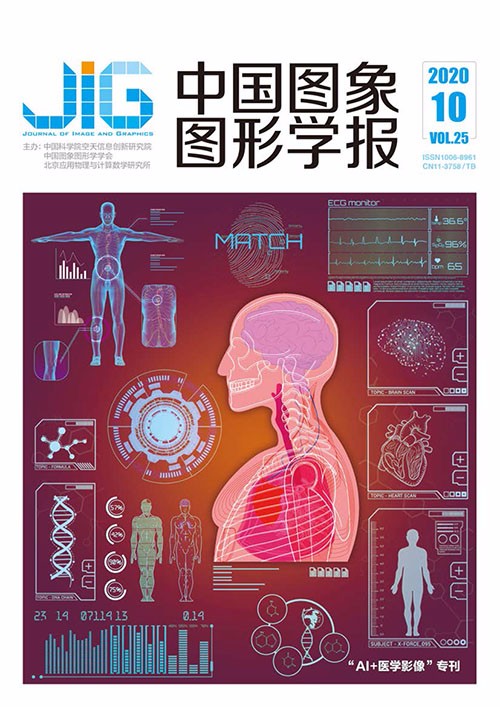
点云算法在医学领域的研究进展
李美佳1, 于泽宽2, 刘晓1, 颜荣耀1, 于媛媛1, 王大明3, 陈涓4, 陆军3, 祁鹏3, 王俊杰3, 刘杰1(1.北京交通大学计算机与信息技术学院, 北京 100044;2.复旦大学工程与应用技术研究院, 上海 200433;3.北京医院(国家老年医学中心)神经外科, 北京 100730;4.北京医院(国家老年医学中心)放射科, 北京 100730) 摘 要
点云作为一种重要的3维数据,能够直观地模拟生物器官、组织等的3维结构,基于医学点云数据的分类、分割、配准、目标检测等任务可以辅助医生进行更为准确的诊断和治疗,在临床医学以及个性化医疗器械辅助设计与3D打印有着重要的应用价值。随着深度学习的发展,越来越多的点云算法逐步由传统算法扩展到深度学习算法中。本文对点云算法在医学领域的研究及其应用进行综述,旨在总结目前用于医学领域的点云方法,包括医学点云的特点、获取途径以及数据转换方法;医学点云分割中的传统算法和深度学习算法;以及医学点云的配准任务定义、意义,以及基于有/无特征的配准方法。总结了医学点云在临床应用中仍存在的限制和挑战:1)医学图像重建的人体器官点云分布稀疏且包含噪音、误差;2)医学点云数据集标注困难、制作成本高,可用于训练深度学习模型的公开数据集非常稀少;3)前沿的点云处理算法大都基于自然场景点云数据集训练,这些算法在医学点云处理中的鲁棒性和泛化能力还有待验证。随着医学点云数据集质量和数量的提升,医学点云处理算法的研究将会吸引更多的研究者。
关键词
Progress of point cloud algorithm in medical field
Li Meijia1, Yu Zekuan2, Liu Xiao1, Yan Rongyao1, Yu Yuanyuan1, Wang Daming3, Chen Juan4, Lu Jun3, Qi Peng3, Wang Junjie3, Liu Jie1(1.School of Computer and Information Technology, Beijing Jiaotong University, Beijing 100044, China;2.Academy for Engineering and Technology, Fudan University, Shanghai 200433, China;3.Department of Neurosurgery, Beijing Hospital, National Center of Gerontology, Beijing 100730, China;4.Department of Radiology, Beijing Hospital, National Center of Gerontology, Beijing 100730, China) Abstract
A point cloud refers to a set of data points in a three-dimensional space. Each point is composed of a three-dimensional coordinate, with object's reflectivity, reflection intensity, distance from the point to the center of the scanner, horizontal angle, vertical angle, and deviation value. The point cloud is obtained by two methods, one is obtained by scanning the target object by the three-dimensional sensing device, such as LiDAR sensor and RGB-D camera, and the other is obtained by reconstruction from two-dimensional medical images. The point cloud can express the geometric position, shape, and scale of the target object. The point cloud has a wide range of applications in areas such as autonomous driving, robots, surveillance systems, surveying and mapping geography, virtual reality, and medicine, which has achieved remarkable results. Many researchers in the field of medical imaging have also devoted themselves to the research of medical image point cloud processing algorithms. Point cloud can intuitively simulate the three-dimensional structure of biological organs and tissues. With important application value in clinical medicine, the classification, segmentation, registration, and other tasks based on medical point cloud can help doctors make accurate diagnosis and treatment. The point cloud-based medical diagnosis has advantages and has the potential for future application in clinical screening diagnosis, personalized medical device-assisted design, and 3D printing. At this stage, deep learning algorithms have achieved remarkable results in tasks such as target detection, segmentation, and recognition. Deep learning algorithms gradually become efficient and popular in tasks such as target detection, segmentation, and recognition. Therefore, increasing point cloud processing algorithms are gradually extended from traditional algorithms to deep learning algorithms. This article reviews the research and progress of point cloud algorithms in the medical field. This review aims to summarize the current point cloud methods used in the medical field and focuses on 1) the characteristics, acquisition methods, and data conversion methods of medical point clouds; 2) traditional algorithms and deep learning algorithms in medical point cloud segmentation; and 3) the definition and significance of medical point cloud registration tasks. This review is based on feature or non-feature registration method. Finally, although the point cloud method has been applied in the medical field, the current application of the point cloud-based frontier method in the medical point cloud is still insufficient. Applying state-of-the-art algorithms to medical point clouds also requires continuous in-depth exploration and research. To date, medical point clouds have been used to assist doctors in completing some diagnostic tasks, but they are still in the process of continuous development and cannot replace the role of clinicians. The clinical application of medical point cloud has some limitations and challenges: 1) In the application research of point clouds in the medical field, the first task is to obtain point cloud data that can accurately characterize disease information. At present, point cloud data acquisition methods are relatively simple. In the future, high-quality point cloud imaging equipment can be combined to obtain accurate medical point cloud dataset. In applied research, the first task is to obtain point cloud data that can accurately characterize medical anatomical structure information. Considering that the morphological structure of human tissues and organs is relatively complex, most of the point cloud data of human organs are obtained by reconstructing medical images (such as (computed tomography(CT)) and (magnetic resonance imaging(MRI)). Therefore, such point clouds are sparsely distributed, with noise and errors. Obtaining accurate and dense medical point cloud datasets from medical images is an important subject to be studied. 2) In addition to facing the challenges of sparse reconstruction and data imbalance in point clouds, the difficulty of labeling medical point cloud data sets, the high cost of data integration, and the inevitable subjective labeling errors are the reasons why deep learning algorithms have not been widely used in the field of medical point clouds. The small amount of sample data and the imbalance of sample data may affect the accuracy of disease diagnosis. In the future, methods such as semi-supervised learning, active learning, and generating samples against the generated network can be used to improve learning accuracy. 3) A large number of medical point clouds are generated in the hospital but are not used to train and improve the diagnostic model. With the emergence of super-resolution algorithms and point cloud up-sampling networks, the prediction of sparse point clouds to dense point clouds based on medical image reconstruction will be an important means to construct high-quality medical point clouds. In the future, with the improvement of the quality and quantity of medical point cloud data sets, the research of medical point cloud processing algorithms will attract more researchers. Current research only focuses on model training and evaluation of specific data sets, which makes the universality of these algorithms challenging. The application and development of point cloud in medical images are currently a hot topic. Although point clouds have gradually penetrated into a considerable number of fields in medicine, the application of the current frontier methods of point cloud processing in medical point clouds is still insufficient. Research work using medical point cloud still needs to invest more research energy and attention.
Keywords
|



 中国图象图形学报 │ 京ICP备05080539号-4 │ 本系统由
中国图象图形学报 │ 京ICP备05080539号-4 │ 本系统由